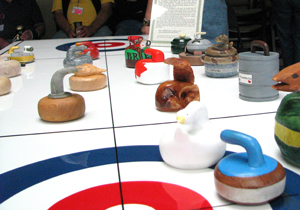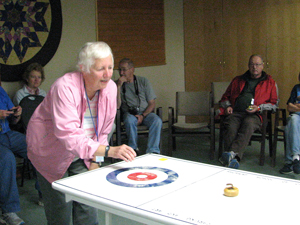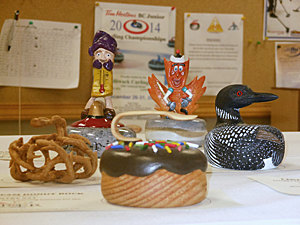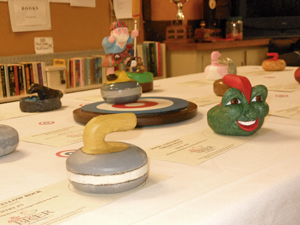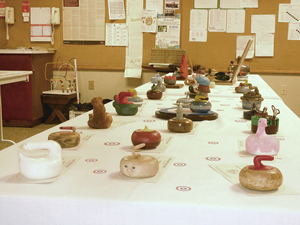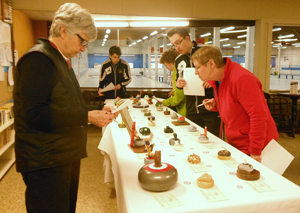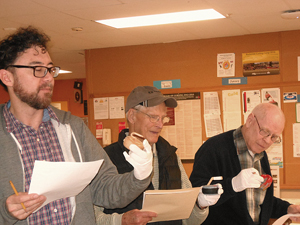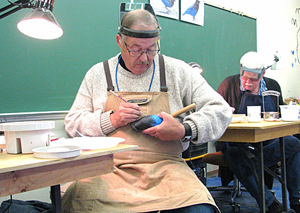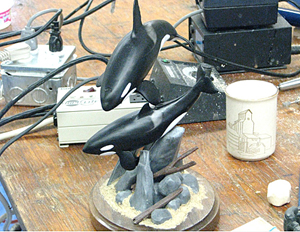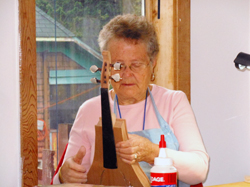
While the Olympic flame no longer burns brightly over Sochi, and its international curling teams are headed home, the spirit of that sport and lively competition continues at curling rinks across Canada this late winter. Next week, in fact, Kamloops, British Columbia (BC), will draw national attention as it hosts the Tim Hortons Brier, March 1-9. “The Brier,” as it is more commonly known, is the annual televised Canadian Men’s Curling Championships, which will award gold, silver and bronze medals to the winning teams. Gold medalists will go on to compete at the world championships in Beijing, China, this year.
Curling enthusiasts who watch the upcoming Brier on TV could be surprised by what they might see during breaks in the action at Kamloops Interior Savings Centre: in one of four corners of the rink will be displayed a unique collection of tiny curling rocks carved of wood and stone or made of clay. Those are being shared by the Shuswap Carvers Society, a local Kamloops-area carving club, which meets one week in September each year to host the Shuswap School of Carving and Arts classes for BC carvers of all sorts. And Kathy Phoenix, its coordinator and treasurer, couldn’t be more excited about the publicity.
“This is a great way to offer fellow carvers an opportunity to participate in a Canadian National event,” she says, “and it furthers the purpose of the Shuswap Carvers Society, which is to encourage an active interest in carving and increase public awareness and appreciation of carving.”
The town of Kamloops has known that it would be hosting 2014’s Tim Hortons Brier for a few years, and Kathy envisioned the opportunity for a fun carving contest early on. The Society had been considering having a scavenger hunt competition during last September’s week of Shuswap carving classes, “but at some point it occurred to me: we should have a Miniature Curling Rock Carving Contest instead.”
So, to up the ante, she contacted the Tim Hortons Brier organizing committee to announce Shuswap Carvers’s Society’s mini curling rock carving contest and see how they might respond. The reply was more than she expected: the committee agreed to have the first- and second-place winning carvings signed by curling team medalists at next week’s Brier, and they invited Shuswap Carvers to share the carvings as a display in one of the four corners of the rink during the competition.
With honors like that at stake, Kathy spread the word about the carving competition and issued the following instructions: use your imagination to create a curling rock carving with a diameter no wider than three inches. Then bring it along to the September school to share for a round of good-natured judging. That call for entries drew 20 carvings, and their carvers pulled out all the stops in terms of inspiration for their “works of art.” There were animal renditions, human caricatures, replicas of actual curling rocks prominent to Canadian curling history, and even some tongue-in-cheek examples. One carving, for instance, took the shape of a “loaded” chamberpot. Another depicts a curling rock steerable by remote control. It seems no curling stone concept was left unturned in the imaginations of the artists.
“Best Carved” and “Most Original” honors were bestowed during the carving week last fall, and participants even shared in a round of competition with their stones on a miniature tabletop curling rink made by one Carving Society member.
But, it quite didn’t end there.
Kathy contacted Woodcarving Illustrated Magazine to make them aware that Shuswap’s contest winners would have their carvings signed by Tim Hortons Brier curling medalists. “The magazine decided to do an article about it,” Kathy reports, “and Shuswap Carvers Society opened the contest up so that the rest of Canada and even beyond could participate.” It set a deadline of January for more contest entries, then extended that deadline to Valentines Day.
That exposure and broader invitation has culminated in a total of 36 miniature curling rock contest entries. Aside from those carved entirely of wood, two entries are in stone, two are a combination of wood and stone, and two, submitted by 11- and 12-year-old artists, are made of clay. Most, but not all, of the carvings from last September’s first contest were resubmitted by their owners for consideration again. Other carvings have come from Manitoba, Alberta and BC. One entry was shipped in from Tucson, Arizona, but Kathy reports that that carver is actually “a Saskatchewan snowbird, so I wouldn’t qualify that as a non-Canadian entry,” she quips.
Last week, judging took place for “Best Rendition (Best Carved)” and “Most Original (Most Quirky)” categories. First, second and third place awards for these categories, plus three honorable mentions in each, were revealed last week and are pictured in the groupings below. A three-person panel of Kamloops-area judges, including a former curler, a respected local carver and the assistant curator of Kamloops Art Gallery, made the difficult choices among so many clever and well-carved examples.
A round of People’s Choice voting has also taken place, when all of the curling rocks were on display at the Kamloops Curling Club. At the time of this interview, Kathy says more than 200 people had submitted their votes for People’s Choice honors, so the response was lively. Results of the People’s Choice voting will be revealed during the Brier week.
Aside from the signatures of some of Canada’s finest men’s curlers, accolades and possible television exposure during the Tim Hortons Brier, carving contest winners will also receive awards from a pool of 15 prizes that have been donated by the Kamloops Art Gallery. Those include one-year gallery memberships, coffee mugs and various artist publications.
Kathy feels both last fall’s original carving contest, and this Canada-wide contest, have been swimming successes, although the time and effort involved in coordinating them has been extensive. “My husband, who’s also a carver in our Society, says the process has been fun,” she laughs, “but he’s pretty sure once is enough!”
She’s hoping that the publicity might not only serve as a good ambassadorship of one of Canada’s most-beloved sports, but also provide some encouragement for others to get involved with the carving arts. And it might even lift the number of registrations for this fall’s Shuswap School prospectus of course offerings. The week-long school tends to draw around 50 carvers, but that enrollment has declined some since 2007, when the school had 91 participants. She speculates that a challenged economy has something to do with the enrollment shift, and there are also more schools now from which carvers can choose to attend.
For a sneak peek at Shuswap’s 2014 prospectus of course offerings (classes will be held Sept. 21 through 26), Kathy says the school will host eight classes, taught by some of Western Canada’s leading instructors, on the following topics: carving and airbrush painting of a smoothie bird; carving and painting of several subjects including a caricature-style bear and leaf bowl, a Northwest Coast Native Hoxhox mask, snowy owl and head bust; deep relief carving; making and decorating a working gypsy harp; and stone carving. Tuition will be $384 per class, plus supplies. Lodging is not included, but many affordable options are available.
To learn more about the Shuswap School of Carving and Arts, and the Miniature Curling Rock Carving Contest, click here.
